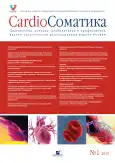Contribution of traditional risk factors to 10-year survival in elderly male patients with coronary heart disease
- Authors: Volkova E.G1, Tantsyreva I.V1
-
Affiliations:
- Department of Therapy, Functional Diagnosis, Preventive and Family Medicine, Ural State Medical Academy of Postgraduate Education, Federal Agency for Health Care and Social Development, Chelyabinsk
- Issue: Vol 1, No 1 (2010)
- Pages: 70-74
- Section: Articles
- URL: https://journals.rcsi.science/2221-7185/article/view/44974
- DOI: https://doi.org/10.26442/CS44974
- ID: 44974
Cite item
Full Text
Abstract
Keywords
Full Text
##article.viewOnOriginalSite##About the authors
E. G Volkova
Department of Therapy, Functional Diagnosis, Preventive and Family Medicine, Ural State Medical Academy of Postgraduate Education, Federal Agency for Health Care and Social Development, Chelyabinskд-р мед. наук, проф., проректор по НИР и международным связям ГОУ ДПО УГМАДО Росздрава, зав. каф. терапии, функциональной диагностики, профилактической и семейной медицины, гл. кардиолог МЗ Челябинской обл.
I. V Tantsyreva
Department of Therapy, Functional Diagnosis, Preventive and Family Medicine, Ural State Medical Academy of Postgraduate Education, Federal Agency for Health Care and Social Development, Chelyabinskканд. мед. наук; зам. гл. врача по медицинским вопросам Муниципального учреждения здравоохранения Городской клинической поликлиники №8 г. Челябинска
References
- Максимова Т.М., Лушкина Н.П. Состав причин смерти пожилого населения как показатель качества медицинской помощи [текст]. Демоскоп Weekly 2009; 369: 370.
- Оганов Р.Г., Погосова Г.В. Современные стратегии профилактики и лечения сердечно - сосудистых заболеваний. Кардиология. 2007; 47(12): 4–9.
- Население России. 2005: тринадцатый ежегод. демограф. докл. [текст]. Отв. ред. А.Г.Вишневский. М.: ГУ ВШЭ, 2007.
- Оганов Р.Г. Несбывшиеся надежды и парадоксы профилактической кардиологии. Кардиоваск. тер. и профилак. 2009; 8(7): 4–9.
- Romero-Corral A, Montory Y.M., Somers V.K. et al.Association of body weight total mortality and wih cardiovascular events in coronary artery disease: a systematic review of cohort studies. Lancet 2006; 368: 666–78.
- Kelli T.L., Gilphin E, Ahnve E et al. Smoking status at the time of acute myocardial infarction and subsequent prognosis. Am Heart J 1985; 535–41.
- Hasadi D, Lerman A, Rihal E.S. et al. Smoking status and outcome after primary coronary angioplasty for acute myocardial infarction. Am Heart J 1999; 137: 612–20.
- Myers J, Prakash M, Froelicher V. Exercise capacity and mortality among men referred for exercise testing. N Engl J Med 2002; 346: 793–801.
- Jolliffee J.A., Rees K, Taylor R.S. et al. Exercise – based rehabilitation for coronary heart disease. Cochrane Database Syst Rev 2001; 1: CD001800.
- Marchioli R, Barzi F, Bomba E. Early protection sudden death by n-3 polyunsaturated fatty acids after myocardial infarction: time course analysis of the Gruppo Italiano per lo Studio della Soptawivenza nell’infarto Miocardico (GISSI) – Prevenzione. Circulation 2002; 105: 1897–903.
- Rich M.W. Heart failure in the elderly: strategies to optimize outpatient control and reduce hospitalizations. Am J Geriatr Cardiol 2003; 12(1): 19–27.
- Sander G.E. High blood pressure in the geriatric population: treatment consideration. Am J Geriatr Cardiol 2002; 11(3): 223–32.
- The Seventh Report of the Joint National Committee on Prevention, Detection and Evaluation and Treatment of High Blood Pressure. JAMA 2003; 289: 2560–72.
- Tresch D.D., Alla H.R. Diagnosis and management of myocardial ischemia (angina) in the elderly patient. Am J Geriatr Cardiol 2001; 10(6): 337–44.
- Stamler О, Stamler R, Neaton JD. Blood pressure, systolic, and cardiovascular risks: U. S. population data. Arch Intern Med 1993; 153: 598–615.
- MacMahon S, Peto R, Cutler О.J. Blood pressure, stroke, and coronary heart disease: Parr1. Prolonged differences in blood pressure: prospective observational studies corrected for the regression dilution bias. Lancet 1990; 335: 765–74
- Staessen J.A., Wang J, Thijs L. Cardiovascular prevention and blood pressure reduction: a quantitative overview update until 1 Match. 2003; 21: 1055–76.
- Wing L.M., Reid C.M., Ryan P et al. Wing For the Second Australian National Blood Pressure Study Group. A comparison of outcomes with angiotensin – converting – enzyme inhibitors and diuretics for hypertension in the elderly. N Engl J Med 2003; 348: 583–92.
Supplementary files







